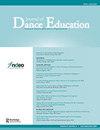Essentials of Dance Psychology
Q1 Arts and Humanities
引用次数: 0
Abstract
Essentials of Dance Psychology satisfies the promise of its title with an impressive, thoroughly researched, and meticulously organized volume that certainly could, as the author suggests, be (1) the foundation of a course in dance psychology, and (2) of great utility to dancers, dance teachers, dance psychologists, therapists, professors, and researchers. The introduction offers an important definition of dance psychology as “the scientific study of mind and behavior as they pertain to dancers, teachers, and dance practice” (2), elaborating on the myriad ways that this general construct is conceptualized. Nordin-Bates defines the overall aim of dance psychology as “enhancement of a range of performance-related and well-being related outcomes” (3). She places dance psychology in a genre inclusive of sports and performance psychologies, thereby elevating the field to its rightful place. The author appropriately integrates evidence-based knowledge and research from disciplines of sports and performance psychology without subsuming dance psychology into fields that historically have had greater attention. Nordin-Bates presents fourteen chapters organized into four parts for easy reference: Part I: Personality, Perfectionism, Self-Esteem and Self-Confidence, and Performance Anxiety; Part II: Motivation, Attentional Focus, and Creativity; Part III: Mindfulness, Goal Setting, Self-Regulation, and Imagery; and Part IV: Motivational Climates, Talent, Injury, and Body Image and Disordered Eating. The introduction and each chapter start with clearly articulated objectives that outline what the reader will be able to describe, understand, and use in practice. Each concludes with key points and recommendations as well as critical aspects of research on the chapter’s topic. Each of these offerings contributes to the excellence of this book as a graceful guide for learners and teachers. The section which discusses critical aspects of research succeeds at guiding, elegantly advocating for, and supporting the growth of the field. The writing is stellar, filling gaps of decades of marginalization or absence of any significant research belonging fully to the field of dance psychology. Adding to the readability and flow of the book is the inclusion of charts, quotes, illustrative black-and-white photos, case studies, and tables with danceand dance research-specific examples. For example, in a SMART Goals table, the S stands for the specificity of a goal, such as “to be able to perform a complex movement sequence while staying on the beat all the way through” (177). Other tables offer practical exercises and ways to measure constructs such as creativity, stress, and talent development. The book also contains a glossary of terms, chapter-bychapter references, and a comprehensive index for easy location of topics. Although Essentials of Dance Psychology provides a wealth of extremely well-grounded, well-researched, and organized information, it is not, nor does it profess to be, exhaustive. It deserves mention, for example, that there is an absence of any discussion of disability, race, gender, or other cultural considerations that affect and influence dance teaching, training, performance, and—certainly— dance psychology. Nordin-Bates writes in her introduction, “Research in dance psychology and consequently the studies and examples represented in this book, mostly represents Western-English-language populations. . . . The field would benefit immensely from more research with other dance populations” (15). Nordin-Bates presents expertise in the theories and constructs of evidence-based cognitive behavioral therapy (CBT). As a child and family psychologist, I have significant knowledge of CBT as it applies to individuals and groups and as it is used for various psychiatric disorders. I have not, until this text, seen it so thoroughly applied to dancers, dance teaching, and dance performance; frankly, it made my heart soar. The profoundly complex realm of dance experiences (including dance psychology) is given language that has potential for meaningful understanding, intervention, and empirical study. To borrow from Nordin-Bates’s chapter on perfectionism, this book is not perfect, nor does it or should it strive for perfectionism. It strives for excellence, in the same way we are encouraged to strive for excellence in our dancing, our teaching, and our research studies. If we set a very high bar of excellence in writing, research, and advancing the field of dance psychology, Nordin-Bates has vaulted over it and gives us the opportunity to do the same with her guidance in Essentials of Dance Psychology.舞蹈心理学概论
《舞蹈心理学要义》满足了其标题的承诺,它令人印象深刻,研究彻底,组织细致,当然可以,正如作者所建议的那样,是(1)舞蹈心理学课程的基础,(2)对舞者,舞蹈教师,舞蹈心理学家,治疗师,教授和研究人员非常有用。引言对舞蹈心理学给出了一个重要的定义,即“对舞者、教师和舞蹈实践的心理和行为的科学研究”(2),并详细阐述了将这一总体结构概念化的无数种方式。诺丁-贝茨将舞蹈心理学的总体目标定义为“增强一系列与表演相关的和与幸福相关的结果”(3)。她将舞蹈心理学置于一个包括运动心理学和表演心理学的流派中,从而将该领域提升到应有的地位。作者恰当地整合了基于证据的知识和来自运动和表演心理学学科的研究,而没有将舞蹈心理学纳入历史上更受关注的领域。诺丁-贝茨共写了14章,分为四部分便于参考:第一部分:人格、完美主义、自尊和自信以及表现焦虑;第二部分:动机、注意力集中和创造力;第三部分:正念,目标设定,自我调节,和意象;第四部分:激励气候,天赋,伤害,身体形象和饮食失调。引言和每一章都以清晰的目标开始,这些目标概述了读者能够描述、理解和在实践中使用的内容。每一章都总结了重点和建议,以及本章主题研究的关键方面。每一个这些产品有助于卓越的这本书作为一个优雅的指导学习者和教师。讨论研究的关键方面的部分成功地指导,优雅地倡导和支持该领域的发展。写作是一流的,填补了几十年来被边缘化的空白,或者没有任何完全属于舞蹈心理学领域的重要研究。增加可读性和流程的书是包括图表,引用,说明性的黑白照片,案例研究,表格与舞蹈和舞蹈研究的具体例子。例如,在SMART Goals表中,S代表目标的专一性,例如“能够在始终保持节拍的同时执行复杂的动作序列”(177)。其他表格提供了实用的练习和方法来衡量创造力、压力和才能发展等概念。本书还包含术语表,逐章参考,以及一个全面的索引,便于定位主题。尽管《舞蹈心理学要件》提供了大量极具基础的、经过充分研究的、有组织的信息,但它不是,也不自称是详尽的。值得一提的是,例如,没有任何关于残疾、种族、性别或其他影响舞蹈教学、训练、表演,当然还有舞蹈心理学的文化因素的讨论。诺丁-贝茨在她的引言中写道:“对舞蹈心理学的研究,以及本书中所代表的研究和例子,主要代表了西方英语人群. . . .这一领域将从对其他舞蹈人群的更多研究中受益匪浅。”Nordin-Bates介绍了基于证据的认知行为疗法(CBT)的理论和结构方面的专业知识。作为一名儿童和家庭心理学家,我对CBT有很深的了解,因为它适用于个人和团体,也用于治疗各种精神疾病。在这篇文章之前,我还没有看到它如此彻底地应用于舞者、舞蹈教学和舞蹈表演;坦率地说,这让我的心飙升。舞蹈体验(包括舞蹈心理学)这一极其复杂的领域被赋予了具有有意义的理解、干预和实证研究潜力的语言。借用Nordin-Bates关于完美主义的章节,这本书并不完美,它也不应该追求完美主义。它追求卓越,就像我们被鼓励在舞蹈、教学和研究方面追求卓越一样。如果说我们在写作、研究和推动舞蹈心理学领域的发展方面设定了一个非常高的标准,那么诺丁-贝茨已经超越了它,并在她的《舞蹈心理学要件》一书中给了我们同样的机会。
本文章由计算机程序翻译,如有差异,请以英文原文为准。
求助全文
约1分钟内获得全文
求助全文
来源期刊

Journal of Dance Education
Arts and Humanities-Visual Arts and Performing Arts
CiteScore
1.80
自引率
0.00%
发文量
47
 求助内容:
求助内容: 应助结果提醒方式:
应助结果提醒方式:


